ASTANA – The New Day exhibition brought together two contemporary artists, Amanat Nazarkul and Vladimir Gvozdev (Shege), and a traditional carpet (tuskiiz) collector, Natalya Krivets, to share with a wider audience their firsthand experiences in art and working methods on April 14 at the Kulanshi Art Center in Astana.

Kulanshi Art Center organized an art talk featuring two contemporary artists and a traditional carpet collector. Photo credit: astanatimes.com
It is rare to find all three artists together with their artworks, so the art talk provided a unique opportunity to explore what lies behind the process of creativity and art – how it is made and displayed.
Despite having distinct styles and outlooks, the exhibition’s curator and artist Leyla Mahat said they were able to create “magic” and align three artists through the concept of the new day that never repeats itself, which is reflected in the works of all three.
The artists invited the audience to join them in discovering different expressions of creativity and ways to engage with art.
Organic lines and spacious sculptures of Nazarkul
Nazarkul’s paintings stand out for their shapes, accentuated geographic elements and lines that are simultaneously precise and organic. The painter produces forms and shapes filled with allegories which he developed from his vision of the contemporary world. His work engages viewers in the same manner as a well-told story.
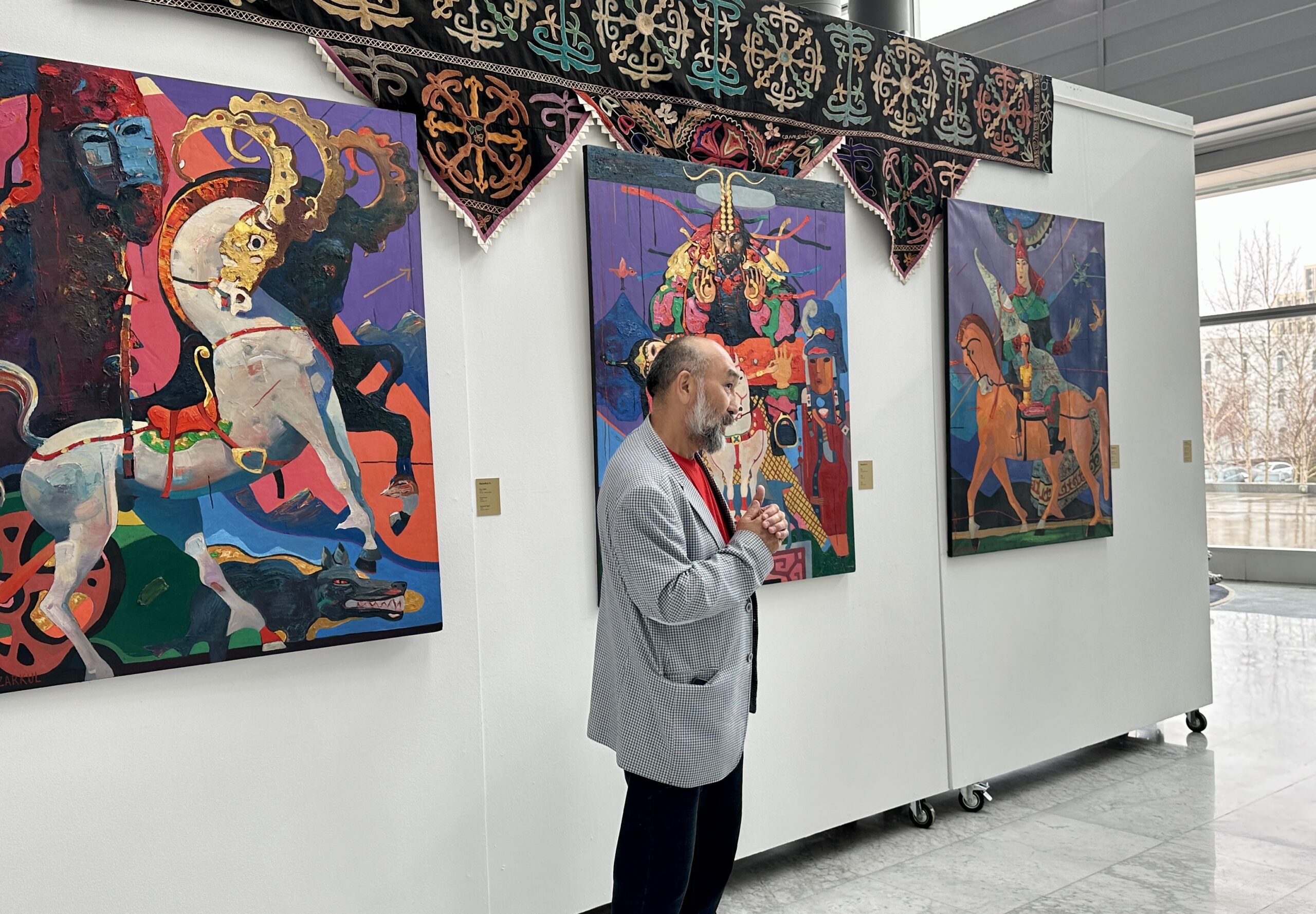
The triptych “The cardiogram of the great steppe” connects the past and the present through symbolism. Photo credit: astanatimes.com
“The line is the subtlest emotion in the human world. Each line must find its place and enrich the human image,” said Nazarkul emphasizing its importance in his delivery method.
He began the interactive talk with his triptych, “The cardiogram of the great steppe,” where the central piece belongs to a large and imposing figure of a Khan (Ruler/King).
Some might narrate the painting as praising a ruler. On the contrary, Nazarkul’s presentation brings a subtle representation of a ruler’s precarious position and critique of modern dictators. The proposed interpretation emerges from symbols and forms that dominate his work.
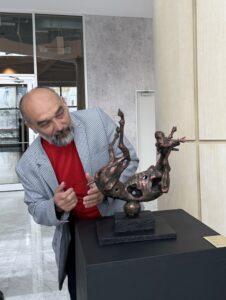
In the “Saiga” piece, the artist Nazarkul touches on ecology and biodiversity issues. Photo credit: astanatimes.com
For example, a horse becomes a throne or power. A woman represents the people entrusted to the ruler. The square that the Khan sits upon symbolizes the instability of his position. “The rider can fall off the square at any time,” said Nazarkul.
Nazarkul does not restrict himself to one medium of expression. He creates immersive sculptures that rely heavily on the aspect of spaciousness.
“I spent many years developing this style. In the beginning, I made sculptures out of leather. I realized that line and space work very strongly. The form itself draws the viewer in – you want to look at it,” he said.
In the “Saiga” piece displayed in the gallery, the artist touches on ecology and biodiversity issues. A flipped-over saiga molded from bronze nods to the history of poaching of this endangered species. The installation is not static. The effect is that of a scene playing out of a saiga shot by the hunter captured in momentum.
Krivets’s ornamental carpets
When the exhibition opened in March, one of the most striking things about the installations were a series of bright hand-woven traditional wall carpets called tuskiiz, which were collected by Krivets.
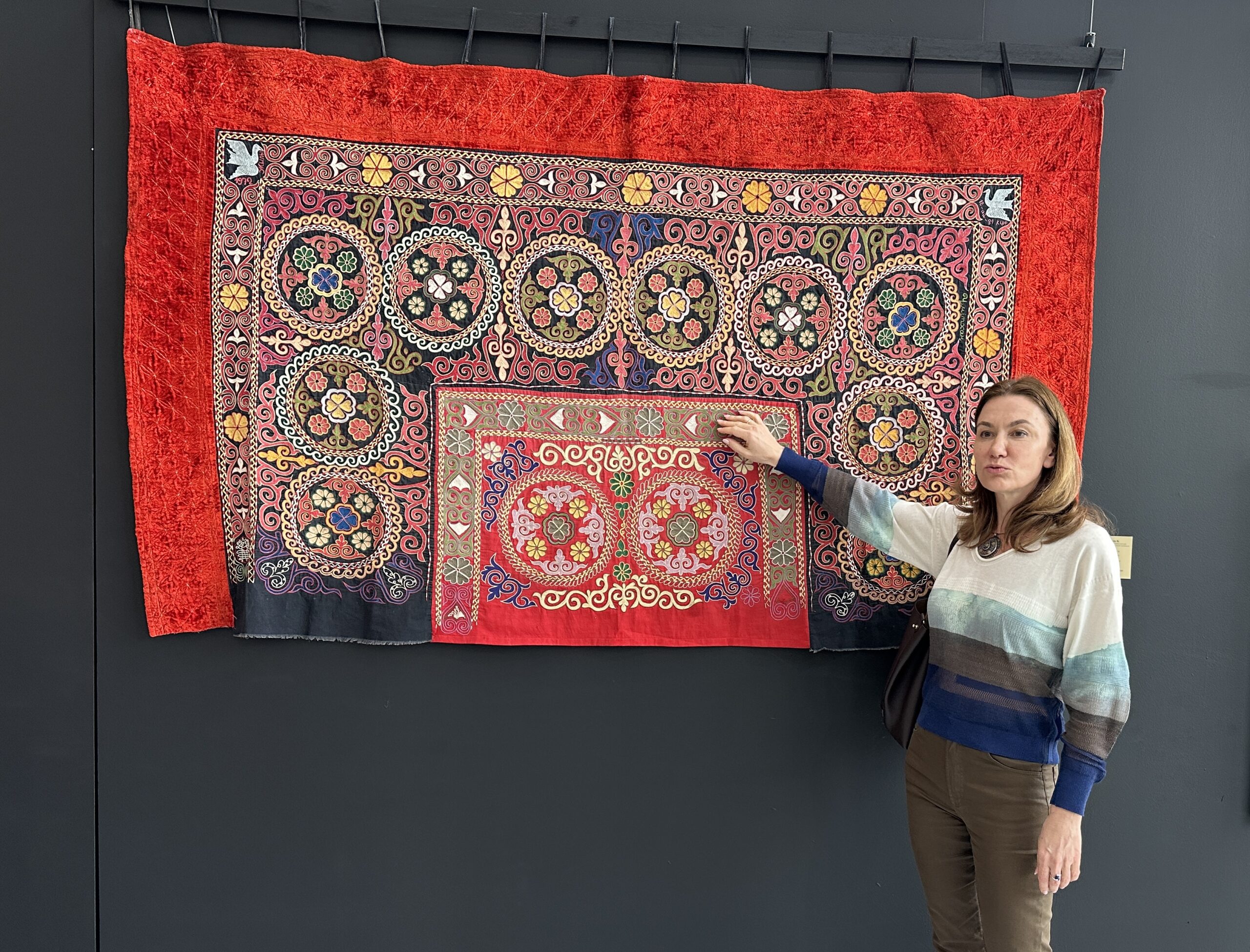
This tuskiiz from 1972 with the embroidered date and the craftswoman’s name is one of Natalya Krivets’s favorites. Photo credit: astanatimes.com
Krivets’s collection explores how the carpets filled with cultural narratives function both as a form of decor and artistic expression of women weaving them. The large-scale works depict centuries-old symbols and traditions that local artisans reproduced through sewing techniques passed through generations.
“There is nothing ordinary in a yurt. Each item becomes both a decorative piece and a sacred object that carries meaning,” said Krivets.
One of her favorite carpets in this exhibition is a Kazakh tuskiiz from 1972.
“It is well preserved. One can see that it has been treated with care. It appears to be a wedding tuskiiz. It was made by a mother who loved her daughter dearly,” she said, pointing to two swans sewed on both sides of the carpet as a symbol of love and union.
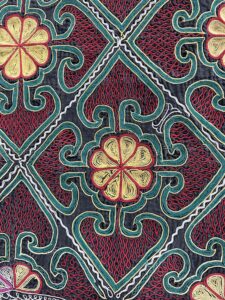
The 1960s carpets are notable for their delicate embroidery and subtle colors. Photo credit: astanatimes.kz
The details on the carpet also contain the name of the woman Umitkhan and embroidered lettering that reads “to Yerkejan,” supposedly her daughter.
“The fact that the craftswoman put her name and date indicates that she was aware that her creation was more than just a yurt interior decoration; it was a work of art that she would pass to her offsprings,” said Krivets.
An attentive observer might notice how sewing styles and colors changed in response to the environment and time women lived in.
“Embroidery in the 1960s is subtle, colors are subdued. In the 1970s, it becomes a little brighter, a little thicker. In the 1980s, you can see that the century is accelerating, that women are already embroidering faster, the colors are much brighter, and the embroidery is larger,” said Krivets.
The collection is also a tribute to the important role that carpet weaving played in Kazakhstan’s early history. Krivets said she hoped the collection would offer visitors an interactive way to engage with Kazakhstan’s past and heritage, and perhaps the exhibition would inspire modern Kazakh women to pick up the old tradition or preserve it.
“Tourism, unfortunately, does not only bring positive benefits,” said Krivets. “[People] begin to embroider quickly to sell, so the skill can be lost. It is important to preserve it.”
Bold colors and textures of Shege
Gvozdev, who works under the artistic name Shege, has received worldwide acclaim for his bold colors and often highly tactile form of art. He mastered a distinctive technique with strokes to create that particular effect of textures to make the canvas bumpy and tactile.
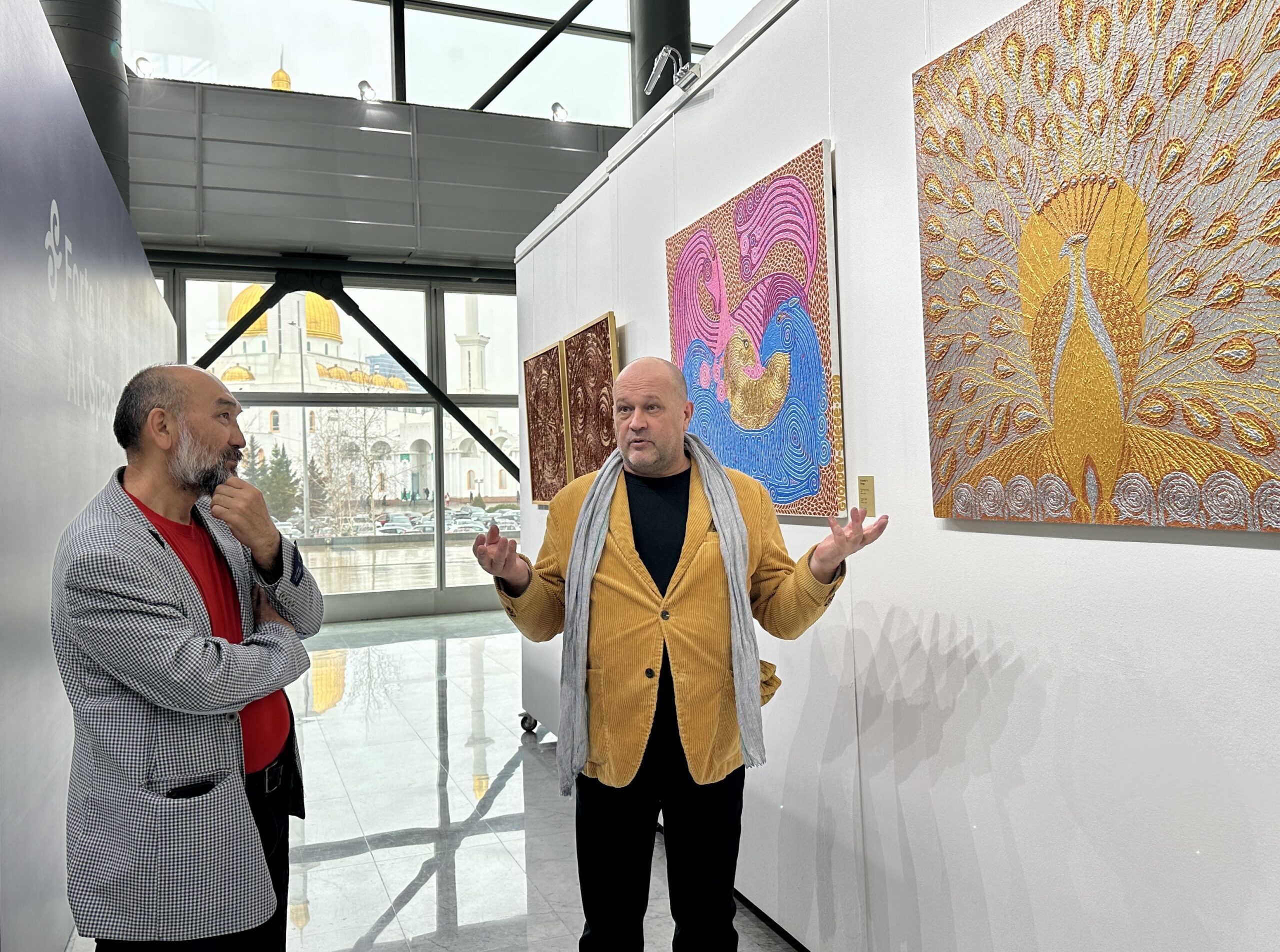
Shege (M) has received worldwide acclaim for his bold colors and often highly tactile form of art. Photo credit: astanatimes.com
His paintings are the physical results of his travels, conversations, and interactions.
Shege created a series of paintings on canvas built on the themes he explored during his travels to Sri-Lanka. He visited the area and observed flora and fauna, which inspired the two paintings called “The Sun of the East.”
The color of the paintings changes at different times of the day soaking in the light. The depicted story echoes the past and present of people in Sri-Lanka.

The realistic texture of the “Sun of the East” painting is achieved through the artist’s distinctive movements of the spatula on the canvas. Photo credit: astanatimes.com
Symbolism, signs, the spiral of life, progress and regress are among the few themes the artist indulges in while painting. Bold and colorful, his paintings dance between the abstract and symbolic.
Shege’s technique is as gripping as his subject matter.
Before he was an artist, he was a carpet seller, and it shows. If one looks at Shege’s densely colored, beautifully textured acrylic paintings, one can see the remnants of an ornate oriental carpet.
“The story began with carpets. There is ornamentalism in carpets. The rugs were letters. They were letters of girls who would weave a rug about their surroundings. It is a millennial code. I wanted to do it in oil on canvas,” said Shege.
Picturesque and full of vital movement, the audience can see the gestures of his drawing spatula on the canvas. From the tactility of the material to the almost three-dimensional spaciousness of his works, there is a liveliness to the way paint is applied.
Great art might take a lifetime to understand, so Shege does not insist on an exact reading of his art. There is always an associative feature to the painting, according to him. He wants to encourage others to indulge their creative side while viewing his works.
“They [viewers] are also contributors,” he said.


